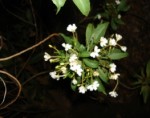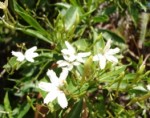Scientific Name: Scaevola gaudichaudii
Also Known As: Mountain Naupaka
Endemic: All HI except Ni’ihau and Kaho’olawe
Description: Small shrubs 3-4 ft. tall with narrow leaves about 2-3 inches long and ½-1 inch wide. The margins of the leaves are slightly serrated as you approach the tip. The most appealing feature of this native plant are their fragrant yellow ‘half flowers. Compared to the other 8 native species of Naupaka, 6 of which are also mountain dwelling (the other two are the common coastal naupaka kahakai (Scaevola sericea) and the Endangered dwarf naupaka (Scaevola coriacea) which is also found near the ocean). This particular species has the most narrow and pointed petals of them all, its very striking. The color of the flower is fairly unusual as well being that it is only one of two yellow flowered species of naupaka, the other being ‘ohe naupaka (Scaevola glabra) which is much more rare and only found in the upper elevation wet forests of the Ko’olau Mts. on O’ahu and on Kaua’i, it too has yellow flowers but their shape is more tubular and similar to that of a native lobelia rather than a naupaka. Once the flowers are pollinated, small black fruit develop with a single seed within.
Distribution: This endemic species is found on all the main islands except Ni’ihau and Kaho’olawe in the dry to mesic forests, quite unlike its other mountain naupaka relatives which reside mostly in higher, wetter areas.
Landscape Use and Care: This plant makes an excellent addition to any yard whether you’re a collector of native plants or not. They require very little water once established in the ground and love full sun. They also seem to be the hardiest compared to the other 6 species of naupaka kuahiwi by showing signs of being resistant to mites and other pests that would normally crinkle and deform the shape of other naupaka leaves. Many times people plant the coastal naupaka kahakai on the ma kai side of the house and naupaka kuahiwi on the ma uka side.
Cultural Uses: The fragrant flowers of various naupaka kuahiwi are used in lei as seen in the book Na Lei Makamae by Marie McDonald and Paul Weissich (a definite must have for everyone especially hula dancers, native plant collectors, lei makers and Hawaiian culture enthusiasts).
Additional Info: All of the nine species of native naupaka are believed to have come from only three separate colonizations. All but one species is endemic, the common coastal naupaka (S. sericea) is indigenous, and represents one of the three colonizations, since it’s fruit float it probably reached here from other places in the Pacific on numerous occasions. The other colonization is believed to be for ‘ohe naupaka (S. glabra) mentioned above, and the third colonization represents the rest of the other native species in which one pioneer species radiated into many other species.
Naupaka Kuahiwi








